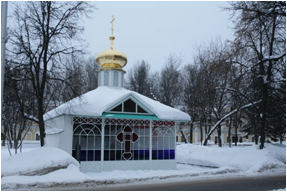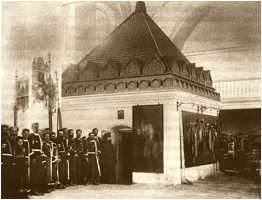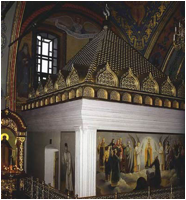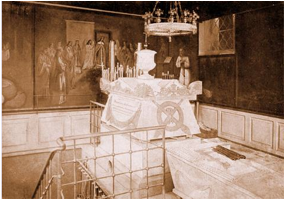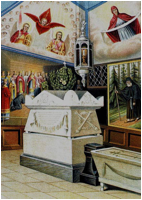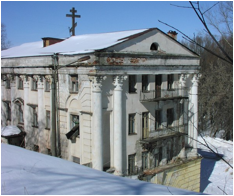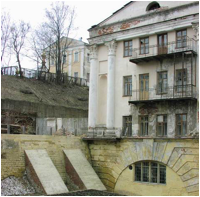The Sarov Desert
A supplement to Saint Seraphim of Sarov.
What is now known as the town of Sarov (Саро́в) likely began its history as a Mordovian settlement (Volgaic Finns) in the 12th century.[1] The location of the settlement was near the confluence of two rivers—the small Sarovka (originally Sarov, from the Finno-Volgaic root word ‘Sar’ which means swamp[2]) with the larger Satis (54°55’36.62”N, 43°19’27.76”E).[3] Sarov lay along the far eastern frontier of the Vladimir-Suzdal princedom of Kievan Russia. Under the rule of Grand Prince Vsevolod III (aka Vsevolod of the Large Nest), 1176-1212, cities, fortresses, churches were built, opposition was suppressed, and systematic raids were conducted against the Volga peoples—most notably the Volga Bulgars. Under the rule of his son Yuri, Nizhny Novgorod (Ни́жний Но́вгород) was founded in 1221 as a stronghold against the Volga Bulgars and Mordovians[4] (who, perhaps, were now more aggressive due to the policies of his father). Presumably at some point during this period a small fort, Ostrog (Острог), was built in Sarov—lying some 100 miles (160 km) in a southerly direction from Nizhny Novgorod—for the same purpose (~230 miles from Moscow).

Map of the approximate extent of the Kievan Rus at the founding of the Sarov fort.[5]

Location of Sarov as viewed from space (Google Earth application).
The Sarov fort was located on top of a low hill formed by the banks of a peninsula shaped by the oblique nature of the junction of the Sarovka and Satis Rivers.

Confluence of the Satis and Sarovka Rivers.[6]
While little is apparently known of the exact nature of these fortifications, an idea of their nature may be given by the reconstruction of a Cossack settlement found at the National Historical and Ethnographic Reserve in Pereyaslav-Khmelnytsky, Ukraine, as in the photograph below.

Reconstruction of a Cossack settlement, Pereyaslav-Khmelnytsky, Ukraine.[7]
While such fortifications may have served to protect the Russians against local threats, they did little to stem the devastating assaults of the Tatars (Mongols) of 1237-1238; Grand Prince Yuri fell in battle, and virtually the entire Russian northeast was laid waste.

Burning of Kyiv by the Tatars in 1240 (provenance unknown).[8]
Thereafter, the Tatars would maintain effective control over Russia until the battle of Kulikovo in 1380, and weak rule until 1480.[9] Circa 1298 the Tartars rebuilt the Sarov fort into a residence for one of their princes[10] and called it Sarakly (yellow sword); the Tartars abandoned the place by 1390.[11]

Left bank of the Satis River (Sarov Monastery Bell Tower in background).[12]

Right bank of the Sarovka River (Sarov Monastery Bell Tower in background).[10]
For over two and one-half centuries the site of the old fort on the hill lay desolate and overgrown. (Actually, since the fort likely had been nothing more than a wooden palisade[13]—possibly with some earthworks—all above ground traces of it would have long since rotted and been washed away.) Then, in 1654, a monk named Theodosius built a hut on the hill and settled in, serving as a missionary of the Gospel to the pagans and schismatics living in the neighboring villages. After Theodosius’ death, the monk John (Ioann, in the world Ivan Fedorovich Popov, the son of the clerk of Red village of the Arzamas district) settled in a cave along the banks of the hill, led the life of an ascetic, and also worked as a missionary to the locals; a community gathered round him, and soon a church was built on the hill. John was followed by Ephraim, and the Gospel light shining from the hill soon began to attract pilgrims. Beginning with Ephraim, the tradition of startzi was established at Sarov in men such as Simon, Joachim, Pakhomius (the abbot at the time Seraphim entered the monastery in 1778), and Nazarus.[14]
As the religious community grew, so did the physical complex that supported it, both above and below ground. For example, the underground Church of Saints Anthony and Theodosius of the Kievan Caves was constructed ca. 1690.[15]

Map of the cave complex under the Sarov Monastery (Church of Saints Anthony and Theodosius of the Kievan Caves is the “large” room in the lower, center part of the illustration).
|
|
Entrance to the Sarov caves. |
|
|
|
Church of Saints Anthony and Theodosius, Sanctuary. |
Church of Saints Anthony and Theodosius, Nave, looking toward the Beautiful Gates. |
In 1706, following consecration of the first temple on 16 June, a monastery was considered to have been formally established in Sarov, the Sarovskaia Pustyn' (Саровская Пустынь) —"The Sarovski Desert" as it means literally in Russian (monasteries for hermit monks were called deserts). Once established, growth and construction proceeded at an ever quickening pace. By 1733 the community of the Sarov monastery had reached 36 monks. In 1744 the first stone temple—the (first) Church of the Dormition—was built and consecrated. In 1752 a second stone church—the (first) Church of Saint John the Forerunner—was built over a spring at the foot of the hill on which the monastery was constructed. By 1758 stone walls, two corner towers, and the main gate had been built to enclose the monastery.

Sarov Monastery as it appeared in a 1764 engraving.
In 1777, the year before St. Seraphim arrived at the Sarov monastery, the Church of the Dormition was rebuilt (or perhaps entirely replaced) on a much larger scale and consecrated as the Dormition Cathedral.

Dormition Cathedral ca. 1903.
As you might recall from the life of St. Seraphim, after suffering from dropsy for three years, he was healed by a touch from the Theotokos. Once he had fully recovered his strength, with the permission of the abbot, St. Seraphim travelled the countryside in search of contributions to build an infirmary and chapel in thanksgiving of his healing; these collections enabled the Church of St. Zosimas and Sabbatius of Solovetz (which saints are jointly commemorated 17 April) to be constructed in 1784; St. Seraphim himself making the Cyprus-wood altar.

Church of Saints Zossimas and Sabbatius ca. 1903 (reconstruction/restoration began in 2009).
During the years 1789 to 1799 a monastery bell tower was built over the main entrance.

Sarov Monastery bell tower ca. 1903.
From 20 November 1794 to 08 May 1810 St. Seraphim retreated from life in the Sarov monastery proper into a deeper “desert” and the life of a solitary. The monastery’s “summer house” (later known as the Far Hermitage) into which he settled was located some five versts (5.3 km or 3.3 miles) away along the Sarovka River.

Location of the Far Hermitage relative to Sarov as viewed from space (Google Earth application).
While living at the Far Hermitage, during the period ca. March 1804 to March 1805 St. Seraphim undertook what was to become his most challenging podvig: spending one-thousand days and nights in prayer on a granite rock; by night he prayed on a boulder located in the forest between his cell and the monastery, and by day on another stone that he had dragged into his cell so as not to be seen by people.

Place of the stone.
By 1999 efforts had been taken to preserve the sites of the hermitages of St. Seraphim and the place of the stone[16] on which the he had prayed (as illustrated above),[17] and even reconstruct some of the buildings involved. It should be noted that the original Far Hermitage was dismantled, moved, reassembled and displayed for five years at Diveyevo, after which it “disappeared”;[18] for the 1903 canonization of St. Seraphim, it was reconstructed, only to be later destroyed by the soviet.

Chapel and Far Hermitage (reconstructed 2000).[19]
When St. Seraphim returned to the Sarov monastery on 08 May 1810 he went into seclusion in his cell for over fifteen years. On 25 November 1825, the Theotokos again appeared to St. Seraphim in a vision, and told him he was now ready to devote himself in ministering to others. People began to flow to Seraphim-as-staretz in such numbers that it disturbed the operation of the monastery. As a partial relief St. Seraphim received the blessing of the abbot to divide his time between life in the forest and at the monastery. On his first day of “freedom” he had traveled about one and one-half miles along the Sarovka toward the Far Hermitage when the All-Holy Theotokos appeared to him, accompanied by the Apostles Peter and John. She beckoned to St. Seraphim, struck the ground with her staff, and a fountain of water gushed forth from an old, long since dried up spring. The water, she told him, had the power of healing, and she placed the spring under his care. Close by the spring, the monks built St. Seraphim a new hut that he would call his Near Hermitage.
|
|
Healing spring. |
|

Near Hermitage ca. 1903.
In 1827 a new, enlarged Church of St. John the Forerunner was built.

Church of St. John the Forerunner (on the right) ca. 1903.

Sarov Monastery in the “XVIII century” [although the Church of St. John the Forerunner at the left edge of this lithograph was not built until ca. 1824 (1827),[20] as noted above].[21]
St. Seraphim died very early in the morning on January 2nd, 1833, and was buried on the south side of the sanctuary of the Dormition Cathedral—in a coffin he had made from a tree trunk—beside the grave of his fellow hesychast, the Monk Mark who had died fifteen years before him (more of Mark later).

Saint Seraphim’s original coffin (photograph taken after his relics had been translated in 1903).
In 1861 a chapel was built over the graves of fathers St. Seraphim and Mark.
|
|
Original chapel ca. 1903. |
Chapel reconstructed 2006. |
In 1864 building of the new Cathedral of the Life-Giving Spring was finished.
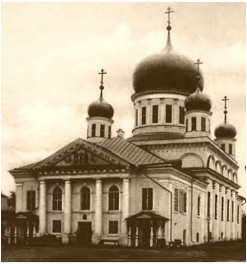
Cathedral of the Life-Giving Spring ca. 1903.
In 1897 construction began on a new church dedicated to Saint Seraphim of Sarov that enclosed the saint’s cell; it was consecrated in 1903 during his glorification.
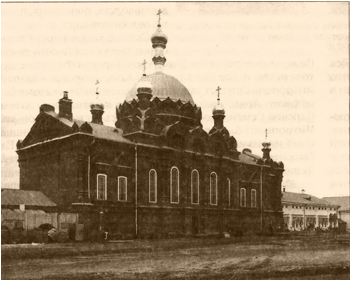
Saint Seraphim of Sarov Temple ca. 1903.
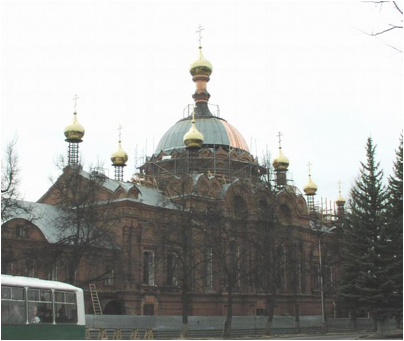
Saint Seraphim of Sarov Temple during restoration (from a theater) during 2002-2003. [22]
|
|
Saint Seraphim’s cell, 1903. |
Reconstructed cell, ca. 2003. |
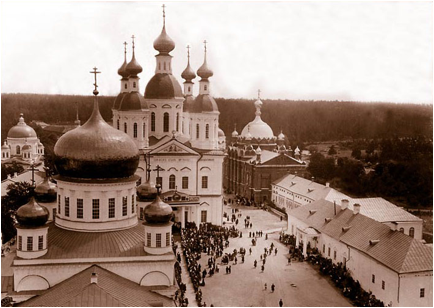
Sarov Monastery in 1903 as viewed from the bell tower.[23] The Cathedral of the Dormition (Успенский Собор) stands highest in the center of the view (the “Summer Cathedral”[24]). The Church of Seraphim of Sarov (1889-1903; built over his cell) is behind and to the right of the cathedral in this view, and the Church of the Theotokos (1748-1758; the “Winter Cathedral of the Life-Giving Spring”[16]) is in the forefront and offset to the left.[25]
As noted in Saint Seraphim’s life, after the processions and services associated with his glorification in 1903, his relics were placed in a marble shrine with a silver cover bearing seraphim at each corner. This reliquary was placed in the chapel that had been built over his grave. Alongside was placed a simpler shrine with the relics of Mark. A crypt was also constructed below the chapel where the faithful could visit Saint Seraphim’s coffin in its original resting place. In A Pilgrimage to Diveyevo by Dr. A.P. Timofievich, it is described in this way: “We...headed for St. Seraphim's grave, where his relics had been venerated for seventy years. That is where the often-described chapel is located at the altar wall of the main cathedral. In it they have now built a pathway leading down to St. Seraphim's grave. Behind a large glass you can see the coffin which was carved out of a log by the hands of St. Seraphim himself and in which he was buried in 1833. After venerating it, we went back up and venerated another grave located in the same chapel, that of the great ascetic Schemamonk Mark.”[26]
|
|
Photograph of St. Seraphim’s reliquary. Note the stairway banister that leads down to the crypt with his coffin. |
Colorized period drawing of the reliquary and surroundings. |
A note concerning the Elder Mark (aka, Mark the Silent, Mark of Sarov, Mark the Hesychast): He was a schemamonk and "sharer of mysteries" with St. Seraphim, and one of those who would visit Seraphim at his hermitage. Mark had a small log-cabin hermitage along the Sarovka River that was closer to the Sarov Monastery than St. Seraphim's hermitages. He reposed November 4th, 1817. St. Seraphim chose to be buried next to him. In one story about Mark it is related: “Towards the end of his life, Elder Mark suffered very much due to his legs: from lengthy standing at prayer and the extremely laborious walks through the wilderness, the Elder's legs became dropsical, swollen, and covered with wounds, so that for a certain time he was unable to walk. Certain of the Sarov brethren, feeling compassion for the Elder in his ailment, advised him to turn to the help of earthly doctors. The Elder, however, did not pay attention to this advice and gave himself completely over to the heavenly Healer of souls and bodies. With faith he took some oil from the lamp which burned before the icon of the Most Holy Mother of God of the Life-giving Fount, located in the cathedral of the Sarov Hermitage, and venerated as a miraculous icon, and anointed his ailing legs with this oil. To the general amazement of those who knew of his disease, he was soon completely healed from it through the grace-given help of the Mother of the Lord, who did not put his hope to shame.”[27] |
Circa 1927[28] the monastery was closed by the Soviet government and the monks were disbanded. Initially the monastery served as a prison camp. Circa 1928 the monastery was converted into an asylum for homeless children, who were forced to build a railroad connecting Sarov to Nizhny Novgorod, which they completed by 1930. “The juvenile delinquents dug up Schemamonk Mark the Hesychast’s grave [opened his reliquary], but fire came out of it and the blasphemers were frightened.”[29]
In 1931, the asylum was closed and the monastery was used to house political prisoners under the administration of the Gulag (Главное Управление Исправительно-Трудовых Лагерей и колоний, "The Chief Administration of Corrective Labour Camps and Colonies"). The prisoners were made to build a huge weapons factory that produced artillery, which was used in World War II, more precisely, the famous "Katyusha" rockets. By this time Saint Seraphim’s hermitages had been destroyed.
In 1946, a committee with the famous scientist Kurchatov at its head decided to use the monastery buildings and the factory to house an atomic research center, Всероссийский научно-исследовательский институт экспериментальной физики (ВНИИЭФ; "All-Union Scientific Research Institute of Experimental Physics, VNIIEF; originally KB-11). The prisoners of the GULAG and German POWs were used in building the research center, the supporting infrastructure (e.g., housing), and also on improvements to the railroad. Sarov has been variously named Arzamas-75 and Arzamas-16 for secrecy reasons; it was one of 10 Soviet closed secret cities, and access remains controlled.
At the beginning of the 1950s the two cathedrals were destroyed, along with other buildings. First to go was the Dormition Cathedral in 1951. The Cathedral of the Life-Giving Spring was destroyed in 1953. Only 29 buildings of the monastery out of the original 40 remain today. St. Seraphim’s spring was also deliberately mired by the local Soviet authorities, and finally cemented over in the 1950s.

A pre-1951 photograph of the Sarov monastery. The Church of St. John the Forerunner has had its dome and cupolas removed. The Cathedral of the Life-Giving Spring has had its main “onion dome” replaced with a simple conical roof, and the four surrounding cupolas have been removed. The dome of the Church of Saints Zossimas and Sabbatius is also not to be seen.
As noted earlier, post-Soviet measures have been taken to restore some of the religious heritage associated with the Sarov monastery. Efforts began in 1992 with the restoration of and first services in the Church of the All Saints (Храм Всех Святых)—used as a hardware store—located outside of the main entrance of the monastery.
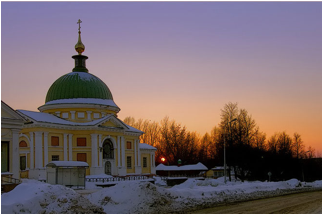
Church of All Saints.[10]
In 1998 the Sarov nuclear center returned the Church of St. John the Forerunner,[30] and regular services are now held there.[31]
|
|
The Church of St. John the Forerunner (Храм Иоанна Предтечи) before restoration.[32] |
Another view of the “Church of St. John the Forerunner”;[33] note new cupolas with crosses awaiting installation on the bank. |
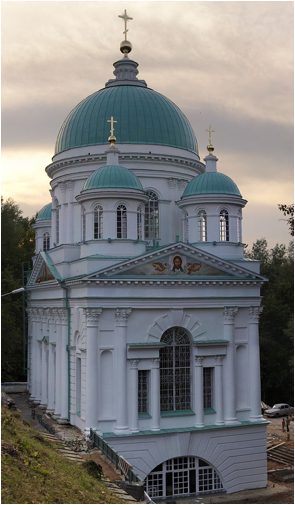
The restored Church of St. John the Forerunner (Храм Иоанна Предтечи).[34],[35],[36],[37]
As noted in the captions of photographs presented earlier, during 2002-2003 the Saint Seraphim of Sarov Temple was restored from having been used as a theater, and his cell was reconstructed on its original foundation. Renovation efforts were also made for the cave Church of Saints Anthony and Theodosius of the Kievan Caves (also see above).[38],[17]
By 2005 a cupola and an Orthodox cross had been restored to the Sarov bell tower. Plans were also put in place to build a new antenna tower ca. 2007 so that the antennas could be removed from the bell tower. Furthermore, the road running through the monastery was to be closed and replaced by a new route ca. 2006.[36]
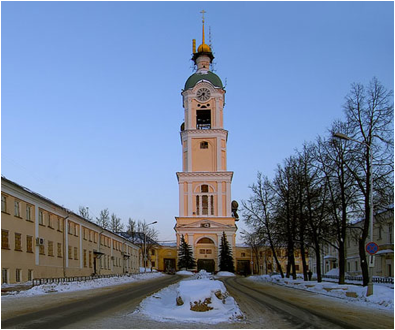
Present day view of the Sarov monastery bell tower.[10]
Reportedly restoration efforts have also been underway at the near hermitage, including an intent to reconstruct the baths (“Tsarist Baths”,[39] evidently in reference to the fact that Tsaritsa Alexandra Feodorovna had bathed and prayed there to St. Seraphim for the birth of a son[40]) as they were in 1903.[41]
In closing it is important to note that, in spite of some restoration works, as far as I was able to determine most, at least, of the monastery grounds remain in the hands of the Russian state, and, for the most part, still house elements of the ВНИИЭФ (VNIIEF). Furthermore, travel to Sarov remains very restricted due to the sensitive nature of the research activities there. However, a small monastic brotherhood had been reestablished in Sarov (three fathers as of 18JUL06).[42]
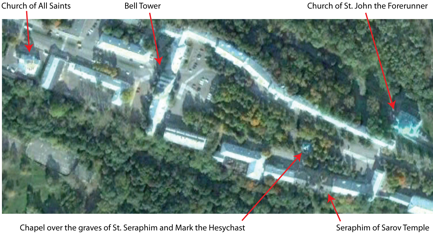
The present-day Sarov monastery proper (enclosed enclave) as seen from space.[3]
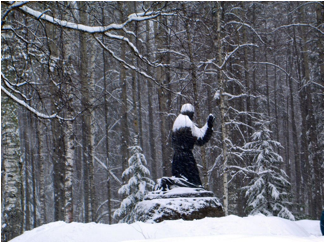
A recent statue of St. Seraphim located outside of Sarov commemorating his podvig (ascetic struggle) of praying on a rock for 1001 days and nights.[43]






